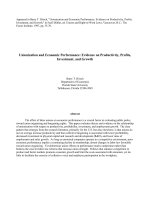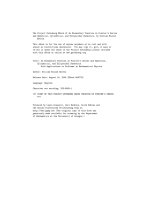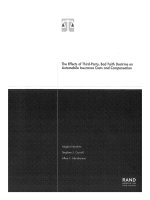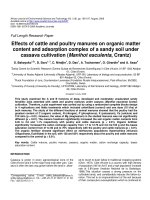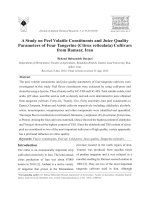Novel filter design on organic single layer and ceramic multi layer substrates
Bạn đang xem bản rút gọn của tài liệu. Xem và tải ngay bản đầy đủ của tài liệu tại đây (2.11 MB, 133 trang )
NOVEL FILTER DESIGN ON ORGANIC SINGLE-
LAYER AND CERAMIC MULTI-LAYER SUBSTRATES
TAN BOON TIONG
(B.Eng.(Hons.), NUS)
A THESIS SUBMITTED
FOR THE DEGRE DOCTOR OF PHILOSOPHY
DEPARTMENT OF ELECTRICAL AND COMPUTER
ENGINEERING
NATIONAL UNIVERSITY OF SINGAPORE
2008
E FO
ABSTRACT
as satellite
of new filter
se of design.
dpass filters have been proposed in this thesis and their detailed analyses
were provided.
ontrolled just
rs were thus
orm of a local defect ground has
also ground return
currents, a novel yet simple filter has been designed and tested.
clude the
gle pair. The
ered that the
quencies were
modes was found to be a function of the difference between the two set of lumped
g attenuati
By combining the above ideas, a new miniaturized resonator was conceived. A
novel Butterfly Radial Stub (BRS) was introduced to load and miniaturize the
resonator and a Local Ground Defect (LGD) was introduced in the ground to act as
the perturbing element. The effect of the latter was electrically modelled by a series
The advancement of modern communication systems such
broadcasting and cellular phone networks has accelerated the evolution
designs as well as techniques with emphasis in compactness and ea
Several ban
A modified microstrip patch with etched away conductor in the centre was
found to exhibit degenerate modes, and the amount of coupling can be c
by tuning the relative positions of the etched holes. Miniaturized filte
designed from this knowledge. A new idea in the f
been investigated and by exploiting the fact that it disturbed the
The dual mode filter has been given a new analysis treatment to in
dual-pair loading of perturbing elements as opposed to the traditional sin
former offered more flexibility in terms of design and it was discov
modified resonator frequency as well as the even and odd mode split f e
all controlled by a similar characteristic equation. The coupling between the split
on
r
element values. Another merit derived from such a topology is that it also allows
bandpass filters to be designed with or without the typical accompanyin
poles.
ii
inductor and a parametric equation was obtained to compute its inductance. A second
d with its second harmonic at l
tim
troduced and
und that the
which it has been sandwiched. The coupling was induced by a pair of square corner
and the amount by its size. A stripline T-junction was also utilized to form the I/O f
this filter and a X-band bandpass filter was realized.
order bandpass filter was successfully designe east three
es away from the filter centre frequency.
A new and robust multilayer bandpass filter topology has been in
embedded in Low-temperature Cofired Ceramics (LTCC). It was fo
bandwidth in such a topology can be adjusted by simply adjusting the two grounds of
or
iii
ACKNOWLEDGEMENTS
individuals of
without their constant encouragement and support, this thesis could not be
possible.
1)
2) Professor Leong Mook Seng, Dept of ECE, NUS
3) rofessor Ooi Ban Leong, Dept of ECE, NUS
4) Mr. Yu Jong Jen
5) Mr. Edward Goh
The author of this thesis wishes to acknowledge the following
whom
Dr. Chew Siou Teck, DSO National Laboratories
Associate P
iv
TABLE OF CONTENTS
Page
ii
iv
v
LIST OF TABLES x
tives 1
2
3
1.3 Thesis Organization 4
RESONATOR
5
2.2 Disk Resonator 6
9
14
3.1 Introduction 15
3.2 Resonator Analysis 17
3.2.1 Theory 17
3.2.2 Coupling Coefficient 17
3.2.3 Susceptance Slope Parameter 18
ABSTRACT
ACKNOWLEDGMENTS
TABLE OF CONTENTS
LIST OF FIGURES viii
1 INTRODUCTION
1.1 Objec
1.2 Main Contributions
1.3 Publications Arising From Research
2 A MODIFIED MICROSTRIP CIRCULAR PATCH
FILTER
2.1 Introduction
2.3 Filter Design and Measurement
2.4 Conclusion
3 A DUAL-MODE BANDPASS FILTER ON PERFORATED GROUND
v
3.3 Filter Design and Fabrication 21
3.4 Conclusion 25
4 S FILTER WITH ENHANCED
2
4.2.1 Odd Mode 31
35
4.4 Filter Design and Measurements 38
47
F LTER WITH
A NEW PERTUBATION
52
52
ce Frequency 57
5.2.4 Modified Resonator Design 60
5.3 Investigation of Dual-Mode Degeneracy 63
5.4 Filter Design and Measurement 67
5.5 Conclusion 78
A DUAL-MODE BANDPAS
CAPACITIVE PERTURBATION
4.1 Introduction 6
4.2 Resonator Analysis 29
4.2.2 Even Mode 33
4.3 Bandpass Filter Analysis
4.5 Conclusion
5 A MINIATURIZED DUAL-MODE RING BANDPASS I
5.1 Introduction 48
5.2 Resonator Analysis and Design
5.2.1 Butterfly Radial Stub (BRS)
5.2.2 Modified Ring Resonan
5.2.3 Loading Factor 59
vi
6 BANDPASS FILTER IN
LOW-TEMPERATURE COFIRED CERAMICS (LTCC)
79
81
8
92
7 CONCLUSION 93
7.1 Suggested Future Works 94
8 APPENDIX I 98
APPENDIX II 109
APPENDIX III 114
9 BIBLIOGRAPHY 118
A DUAL DEGENERATE MODE X-BAND
6.1 Introduction
7
6.2 Resonator Design and Analysis
6.3 Filter Design
6.4 Conclusion
vii
LIST OF FIGURES
UR PAGE
1a 7
2.1b A modified disk resonator with 4 etched holes 7
d 8
2.3 9
2.4 Proposed filter with offset etched holes along AA' 10
.5 ifferent offsets along 11
esults of bandpass filter 13
er 14
3.1 ode resonator 16
3.2 Coupling coefficient chart of degenerate Modes 18
.3 (a) one port a d (b) 19
21
measured results 25
4.1 27
y 29
30
31
33
4.6 ation of the characteristic equation 38
e 40
e case of (a) 45
.1 (b dual
r
50
5.2 (a) A quarter section of the modified ring resonator and its
(b) circuit equivalent
53
5.3 Effects of varying (a) fan angle α and (b) outer radius r
2
on
the effective capacitance of the BRS
55
5.4 Simulated and measured results of the unloaded and
modified ring resonant frequencies
63
FIG E
2. A microstrip disk resonator
2.2 Simulated results with and without etched hole
Simulated and Measured results of the modified resonator
2 Simulated coupling coefficients for d
AA'
2.6 Measured and Simulated r
2.7 Out-of-band response of bandpass filt
Proposed new dual m
3 Representation of resonator in n
transmission line equivalent
3.4 A two stage bandpass filter
3.5 Comparison of simulated and
A weakly coupled microstrip ring resonator
4.2 Proposed dual mode ring resonator topolog
4.3 Newly proposed dual mode resonator
4.4 Odd mode equivalent circuit of ring resonator
4.5 Even mode equivalent circuit of ring resonator
Graphical represent
4.7 External Q-Factor Q
E
against coupling capacitanc
4.8 Response of the designed filter at 1.9 GHz for th
C1 > C2 and (b) C2 > C1
5 Structure of (a) modified ring resonator and
degenerate mode resonato
)
viii
5.5 64
5.6 f LDG (a) underneath the microstrip and its (b) 65
5.7 prising of (a) BRS 72
red results for (a) narrow band and (b) 75
77
6.1 cal LTCC module layout 80
n (a) perspective view, and (b) 82
t circuits 84
6.4
.5
e
as a function of h 88
n measured and simulated results 92
7.1 Connecting pins between upper and lower conductors 95
7.2 Symmetrical Feed system 96
7.3 Asymmetrical Feed system 97
Detouring ground current
A section o
equivalent circuit
ADS definition for the section of arm com
only and (b) LGD underneath BRS
5.8 Simulated and measu
wide band performance
5.9 Photograph of designed filter
Typi
6.2 Stripline SRR configuration i
side view
6.3 Odd and even mode equivalen
A square perturbation with side d 86
6 External Q-factor Q
6.6 Comparison betwee
ix
LIST OF TABLES
TABLE
PAGE
2.I nd Simulated Results
3.I eters 18
3.II Comparison of Simulated and Measured Results 24
4.I Summary of Design Parameters 31
Results fo
1
>C
2
44
red Results for C
2
>C
1
44
5.I Summary of Design Dimensions of Modified Ring
Resonator
47
5.II Summary of Filter Parameters 52
5.III Comparison of Simulated and Measured Results 74
6.I Filter Specifications and Parameters 89
Summary of Designed a
Summary of Design Param
4.II Comparison of Simulated and Measured r C
4.III Comparison of Simulated and Measu
x
CHAPTER 1
INTRODUCTION
s has dema
novel filter topologies featuring miniaturized and light-weight designs [1][2][10][32].
The accompanying design techniques also have to demonstrate ease of desig
Conventional fil
9] topologies.
ed filters [51]
novel filter
topologies as well as design techniques have to be explored to cater to new demands.
They must not only be applicable to single layer substrate, but they must also be
compatible in multilayer packaging solutions such as one Low-Temperature Cofired
Ceramics (LTCC) [41][50]. The suggested LTCC multilayer packaging technique
over here is based on co-firing of pre-defined layers of “green” or raw tapes at a
comparatively low curing temperature usually at about 850
48]. The ability to
embed passive component such as RLCs and filters in the substrate body as well as to
construct cavities for MMIC placement have been very much well received by the
1.1 Objectives
Two objectives are set to be accomplished in this thesis. The main objective is
to develop new novel filter topologies that are suitable for both single and multilayer
substrate body integration. The second objective is the requirement that the design
The recent development of communication system nded a slew of
n as well
as fabrication so as to minimize turn-around time for these filters. ter
designs have chiefly centered on LC, interdigital as well as combline [1
Lately, high performance High Temperature Superconductors (HTS) bas
have also began their presence in cellular base stations. However, new
C°
[
industry.
1
techniques must feature compact integration and layout that is simple to construct.
The focus of this thesis is in the 2.0 GHz to 2.4 GHz communication band for the
planar filters fabricated on top of a piece of organic substrate, with the exception of
the embedded filter which was in the X-band. The de ail information
bandwidth and centre frequencies are specified in the respective chapters.
1.2 Main Contributions
With the two objectives in mind, five filters were designed and fabricat
altogether in this thesis. Four of them were filter topologies realized on a single lay
organic substrate, such as RT/D s Corporation. The fifth is
an embedded filter in LTCC with stripline I/O interface. All of these filters have been
explored and successfully
• cells has be n
main advantage obtained in this modified patch resonator is
min nerate modes
h good out-of-
band rejection f
• Chapter 3 – A new idea of a local perforated ground to perturb the ground return
currents is investigated experimentally
ques to control th between t e
dual degenerate modes can be controlled and very compact filters are designed.
• Chapter 4 – Two pairs of capacitors are incorporated into a ring resonator to
perturb the dual generate mode frequencies. In doing so, the self resonant
frequency can now be controlled by a single characteristic equation, and so are
t on the
ed
er
uroid laminates from Roger
investigated. They are summarized as below:
Chapter 2 – A new planar circular microstrip patch with etched e
proposed. The
electric iaturization and ease of implementation. The dual dege
in this a realize a high performance wit
ilter.
al
resonator re exploited to
in this filter design. Using etching
techni e size of these perturbations, the coupling h
2
the even- and odd-mode frequencies. The coupling coefficient of the filter can
e difference in the capacitanc o pairs of
. The capacitor arrangement also allows the designer to miniaturize t
• ], a Butter
e. Tw
pairs of BRS are incorporated into a ring resonator and a Local Defect Ground
onstrated using this technique.
• Chapter 6 – A Stacked Ring Resonator (SRR) i the
rner has been
e of the degenerated dual m des. A simple stripli
input/output (I/O) scheme is deployed to connect the filter to other exposed active
oncept.
1
t of publications arising from the work reported in this thesis.
1. ed Microstrip
r,” IEEE Microwave and Wireless Comp. Lett.,
vol.12, no.7, Jul. 2002.
2. B. T. Tan, J. J. Yu, S. T. Chew, M. S. Leong and B. L. Ooi, “A dual-mode
bandpass filter on perforated ground,” Proc. Asia-Pacific Microwave Conf.
(Korea), vol.2, pp. 797-800, Nov. 2003.
be
shown to be a function of th es of these tw
capacitors he
ring resonator.
Chapter 5 – By combining the experience gained in [9] and [23 fly
Radial Stub (BRS) is proposed as a form of miniaturization loading schem o
(LDG) i plementation is proposed as the perturbation scheme. Quality filters
have been dem
s proposed with intent to
incorporate it into a multilayer LTCC substrate body. A square co
devised as the coupling schem o
m
filter has been buil st
ne
devices such as MMICs. A rate this ct to illu
.3 Publications Arising From Research
Below is the lis
B. T. Tan, S. T. Chew, M. S. Leong and B. L. Ooi, “A Modifi
Circular Patch Resonator Filte
3
3 A dual-mode
turbation,” IEEE Trans. Microwave
Theory Tech., vol. 51, no. 8, pp. 1906-1910, Aug. 2003.
4 miniaturized
dual-mode ring bandpass filter with a new perturbation,” IEEE Trans.
Microwave Theory Tech., vol. 53, no. 1, pp. 343-348, Jan. 2005.
5. B. T. Tan, S. T. Chew, . S. Leong and B. L. Ooi, “A Dual Degenerate Mode X-
Band Bandpass Filter in LTCC," Microwave and Optical Tech. Lett., vol. 48, no.
11, pp. 2246-2249, Nov. 2006.
This thesis is organized into seven chapters with Chapter 1 as the introductory
chapter. Chapters 2 to 6 describe the work done in this thesis, mainly comprising of
s. Chapters 2 to 5 de
with single layer substrate implementation, while Chapter 6 proposes a topology th
is suitable for multilayer integration such as in LTCC. Chapter 7 summarizes the
overall work done and concludes the thesis. Some prospective ideas are also discuss
for future development.
. B. T. Tan, J. J. Yu, S. T. Chew, M. S. Leong and B. L. Ooi, “
bandpass filter with enhanced capacitive per
. B. T. Tan, J. J. Yu, S. T. Chew, M. S. Leong and B. L. Ooi, “A
M
1.4 Thesis ganization
new filter topologies an their corresponding detailed analysi al
at
ed
Or
d
4
CHAPTER 2
A MODIFIED MICRO IRCULAR PATCH RESONATOR
FILTER
2.1 Introduction
Microwave resonators are widely employed in a myriad of applications such
ular stubs are
s approach is
filter [3][8]. In [4], it has been demonstrated that a square microstrip resonator can
round plane
holes off the
It is
compared to the conventional disk resonator of the same size. Filter response
achieved by offsetting the positions of some of these holes. The coupling level with
respect to the amount of offset is then characterized. A commercial EM simulator
(IE3D) [5] is used to simulate the filter response. A two-pole bandpass at 2.0 GHz
filter with a bandwidth of 8% is designed and measured.
STRIP C
as filters, oscillators and tuned amplifiers. There is a strong interest in the wireless
communication community to miniaturize such resonators. In [1], triang
used to achieve miniaturization by exploiting the slow-wave effect. Thi
also adopted in [2] whereby slow-wave open-loop resonators are employed. It has
been shown that a resonator with dual degenerate modes can also be designed as a
also exhibit filter characteristics by etching periodic structures on the g
underneath with some defects.
In the present work, a filter is designed by etching four circular
microstrip disk resonator instead. This allows ease of assembly and packaging.
also expected that the modified resonator will exhibit a lower resonant frequency, as
is
5
2.2 Disk Resonator
g a perfect magnetic wall at r = a. The
dominant TM
110
mode resonant frequency is given by:
The resonant frequency of a microstrip disk resonator, as shown in Figure
2.1(a), can be readily approximated usin
r
a
c
f
επ
2
841.1
0
110
=
(2.1)
wh
ith a d nt
ere c
0
is the speed of light.
For a 2.4 GHz resonator using RT6010 w ielectric consta
r
ε
of 10.2
to be 11.47
mm. The resonator is then analyzed using an EM software (IE3D). The simulated
resonant frequency is 2.39 GHz, showing good agreement with the closed-form
equation. Table 2.1 is a summary of the results.
T
ABLE 2.1 SUMMARY OF DESIGNED AND SIMULATED RESULTS
Centre Frequency Radius
and thickness 0.635 mm, the radius a of the circular patch is computed
Designed 2.40 GHz 11.47 mm
Simulated 2.39 GHz 11.47 mm
6
7
Fig. 2.1a: A microstrip disk resonator
R
R
r=3.3mm
Fig. 2.1b: A modified disk resonator with 4 etched holes
In Figure 2.1(b), four circular holes each of radius, r, 3.3 mm were etched off
φ
o o o o
There is still
D.
minant mode
y, and this is
the dominant frequency was shifted from 2.4 GHz to 2.0 GHz as shown in Figure 2.2.
the patch at positions R = 6.47 mm,
= 45 , 135 , 225 and 315 .
symmetry in the layout. The structure is then simulated using IE3 Through
simulation, it has been observed that the hole-size affe
inant frequenc
due to the longer electrical path length carved out by the etched holes. In our design,
cts the do
frequency. A larger hole-size will result in a lower dom
Fig. 2.2: Simulated results with and without etched holes
8
A modified disk resonator is then fabricated according to the specifications
compared against the experimental ones,
as sho
and modifi d
on is achieved, resulti g in about 30
savings of real estate and hence a more compact packaging in terms of lateral estate
measured results of the modified resonator
2.3 Filter Design and Measurem
The unique 90° apart placement of the I/O ports induced a pair of non-coupled
orthogonal modes of the same frequency in the resonator. If there is a perturbation
along the symmetry such as along AA’ in Figure 2.4, the orthogonal modes will split,
resulting in so-called degenerate modes. As the modified resonator maintains
given above. The simulated results are then
wn in Figure 2.3. Both sets of S
21
results for the original e
resonators are in good agreement. Miniaturizati n %
.
S21
S11
Fig. 2.3: Simulated and
ent
9
symmetry, it is capable of supporting a pair of dual degenerate modes. Hence
adopting the same approach in [4], the filter is designed as shown in Figure 2.4.
at r = 6.47
mm to create a resonan
along axis AA’ will caus cited. Hence the amount
of offset alo er mode. This
affects the b
Fig. 2.4: Proposed filter with offset etched holes along AA'
There is symmetry along axis AA'. Initially, the holes are located
t structure at 2 GHz. An offset in the position of the holes
e the other degenerate mode to be ex
ng AA' will determine the amount of coupling to the oth
andwidth as well as its passband performance.
10
To characterize this coupling between the two modes, various position offs
ode resonant
ient of coupling [8]. Figure
2.5 shows the coupling coefficient with respect to the position offsets.
to red ur esonant frequen
of the resonator from 2.4 GHz to 2.0 GHz. If the area of the disk is used as a figure
merit to qualify the reduction, the etched holes have then achieved a 17% reduction in
real estate.
A filter is thus specified at 2.0 GHz with a fractional bandwidth of 12%. The
interstage coupling coefficient of a pair resonator can be determined by using (2.3)
ets
along AA’ are simulated using IE3D. The two EM-simulated split m
frequencies are then noted for computation of the coeffic
Fig. 2.5: Simulated coupling coefficients for different offsets along AA'
A disk resonator of resonance frequency of 2.4 GHz is first selected. From the
above work, the etched holes have managed uce the nat al r cy
of
11
[17]. Thus k is determined to be 0.085 and an offset of 1.6 mm is selected. The design
steps are summarized as follows:
Step 1: Define and characterize a parameter which will induce split mode frequencies.
In this ca the position offset, s (= r-r’), from the original location of the two
etched holes is the determining parameter.
Step 2: Measure the split frequencies, f
1
and f
2
, and compute the coupling coefficient
K using the following [51] equation:
se,
2
2
2
1
2
2
2
1
ff
ff
K
+
−
=
(2.2)
Step 3: Define the two most important parameters of the intended filter which are the
centre frequency f and fractional bandwidth
ω
.
Step 4: Using a two-stage resonator [17] to model the coupling split modes, we can
determined the coupling coefficient k using:
21
gg
k
ω
= (2.3)
where g
1
and g
2
are the normalized low pass prototype elements. For a two
stage filter, g
0
= g
3
= 1 and g
1
= g
2
=
2
.
Step 5: Equate the above two coupling coefficients, K = k, and the corresponding
position offset s is determined.
Step 6: Verify and optimize, if necessary, in a EM simulator like IE3D.
12
Simulation of this filter shows an insertion loss of 0.37 dB and a return loss of
th sides f ε
r
10.2 and
thi n
are shown in
the measured
ith a return loss of 34 dB. The measured fractional
bandwidth is about 8%.
Fig. 2.
bandpass filter
The out-of-band response is also measured and shown in Figure 2.7. A second
passband was observed at 3.25 GHz and this is the next higher order resonance mode
of this filter. It is not harmonically related to the fundamental frequency as the
resonator structure is not shaped as a function of the half wavelength. The wideband
27 dB at 2 GHz. Due to the symmetry along AA’, two additional zeros are observed
on bo of the passband. The filter is f a substrate o
ck ess 0.635 mm. The simulated and measured results for S
abricated on
11
and S
21
Figure 2.6. The resonant frequency is observed to be at 2.01
insertion loss is 0.614 dB w
GHz and
S21
S11
6: Measured and Simulated S
11
and S
21
results of the
13
simulated and measured results are shown in Figure 2.7 for comparison. Both results
are in good agreement.
nator
in the resonant frequency whereas their
relative position has minimal effect on it. A dual mode bandpass filter is also designed
by taking advantage of the existing structure and offsetting the circular holes along
the diagonal axis of symmetry. A filter designed at 2.0 GHz shows good agreement
between simulated and measured results for both S
11
and S
21
parameters.
Fig. 2.7: Out-of-band response of bandpass filter
2.4 Conclusion
Circular holes etched off the conductor surface of a microstrip disk reso
actually determines the amount of reduction
have been shown to reduce the fundamental resonant frequency. The size of each hole
14
CHAPTER 3
A DUAL-MODE BANDPASS FILTER ON PERFORATED
GROUND
3.1 Introduction
The microstrip dual mode ring bandpass filter has been studied extensively
brication and
een shown to
troduction of
The role as well as the nature of a perturbation in the bandpass filter is important as it
f ine the
te clude use f
tly, photonic
[4], the perturbation is caused by a defect [7] in the PBG cells. In [11], the excitation
tor. However,
placement of perturbation on conductor trace may affect overall quality factor and
consequently change the characteristics of the filter.
In this chapter, a perforation in the form of a circular patch being etched off
from the ground plane [37] is introduced. From the knowledge of return current in the
over the last few years [4], [9]-[11], [13] and at least two book chapters [14][15] have
been devoted on it. The reasons for its popularity include ease of fa
design, high quality factor and compactness. The ring resonator has b
support two degenerate orthogonal modes [15] and by careful in
perturbation along the periphery of the ring, coupling between the two modes results.
can influence the bandwidth, the location o its poles and even determ
condition for the existence of its poles.
Various novel perturbations have been repor d and they in o
lumped elements [9], stepped-impedance resonator [10] and rec n
bandgap [4]. The perturbations in [9]-[10] are placed on the microstrip itself while in
e
of the split modes is caused by the etched holes on the disc resona
15
